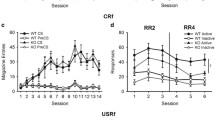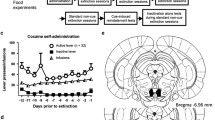Abstract
In a previous experiment we found that destruction of the ascending 5-hydroxytryptaminergic (5HTergic) pathways by microinjection of 5,7-dihydroxytryptamine into the dorsal and median raphe nuclei resulted in impaired acquisition of temporal differentiation under an interresponse-time-greater-than-15-s (IRT>15 s) schedule of sucrose reinforcement. This paper reports three experiments, the results of which bear on the interpretation of that finding. In Experiment 1, 32 rats were trained for 120 sessions under the IRT>15 s schedule; then 16 received lesions of the 5HTergic pathways and 16 received sham lesions. Comparisons of the IRT frequency distributions of the two groups showed that the lesion produced a significant reduction of the mean IRT and an increase in the dispersion of IRTs, as expressed by the coefficient of variation. Obtained reinforcement rates were significantly reduced in the lesioned group, but response rates were not significantly altered. Levels of 5HT and 5-hydroxyindoleacetic acid were markedly reduced in all forebrain areas examined, without significant change in noradrenaline and dopamine levels. The results indicate that destruction of the 5HTergic pathways disrupts performance as well as acquisition of temporal differentiation. Experiments 2 and 3 examined whether changes in deprivation level and reinforcer magnitude, which are known to affect reinforcer value, would influence temporal differentiation in a similar fashion to destruction of the 5HTergic pathways. In experiment 2, 20 rats were trained under the IRT>15 s schedule while maintained at 80% or 90% of free-feeding body weight; the more severe deprivation condition was associated with alonger mean IRT and alower coefficient of variation. In experiment 3, 16 rats were trained under the IRT>15 s schedule using 100 µl or 20 µl of a 0.6 M sucrose solution as the reinforcer; indices of temporal differentiation did not differ between the two conditions. These results indicate that the deleterious effect of destruction of the 5HTergic pathways upon timing behaviour is unlikely to be secondary to the motivation enhancing effect of the lesion.
Similar content being viewed by others
References
Altman HG, Normile HJ (1988) What is the nature of the role of the serotonergic nervous system in learning and memory; prospects for development of an effective treatment strategy for senile dementia. Neurobiol Aging 9:627–638
Altman HJ, Normile HJ, Galloway MP, Ramirez A, Azmitia EC (1990) Enhanced spatial discrimination learning in rats following 5,7-DHT-induced serotonergic deafferentation of the hippocampus. Brain Res 518:61–66
Asin KE, Fibiger HC (1984) Spontaneous and delayed spatial alternation following damage to specific neuronal elements within the nucleus medianum raphe. Behav Brain Res 13:241–250
Baumgarten HG, Jenner S, Bjorklund A, Klemm HP, Schossberger HG (1982) Serotonin neurotoxins. In: Osborn NN (ed) Biology of serotonergic transmission. Wiley, Chichester
Bizot JC, Thiebot MH, LeBihan C, Soubrie P, Simon P (1988) Effects of imipramine-like drugs and serotonin uptake blockers on delay of reward in rats. Possible implication in the behavioral mechanism of action of antidepressants. J Pharmacol Exp Ther 246:1144–1151
Bradshaw CM, Szabadi E (1989) Central neurotransmitter systems and the control of operant behaviour by “natural” positive reinforcers. In: Liebman JM, Cooper SJ (eds) The neuropharmacological basis of reward. Oxford University Press, Oxford
Bradshaw CM, Szabadi E, Bevan P (1981) Relationship between response rate and reinforcement frequency in variable-interval schedules. II. Effect of the volume of sucrose reinforcement. J Exp Anal Behav 35:263–269
Bradshaw CM, Szabadi E, Ruddle HV, Pears E (1983) Herrnstein's equation: effect of deprivation level on performance in variable-interval schedules. Behav Anal Lett 3:267–273
Catania AC (1970) Reinforcement schedules and psychophysical judgments: A study of some temporal properties of behavior. In: Schoenfeld WN (ed) The theory of reinforcement schedules. Appleton-Century-Crofts, New York
Conrad DG, Sidman M, Herrnstein RJ (1958) The effects of deprivation upon temporally spaced responding. J Exp Anal Behav 1:59–65
Deakin JFW (1983) Roles of serotonergic systems in escape, avoidance and other behaviours. In: Cooper SJ (ed) Theory in psychopharmacology, vol 2. Academic Press, New York
Harzem P (1969) Temporal discrimination. In: Gilbert RM, Sutherland NS (eds) Animal discrimination learning. Academic Press, London
Heffner TG, Hartman JA, Seiden LS (1980) A method for the regional dissection of the rat brain. Pharmacol Biochem Behav 13:453–456
Herrnstein RJ (1970) On the law of effect. J Exp Anal Behav 13:243–266
Heyman GM, Monaghan MM (1987) The effect of changes in the response requirement and deprivation on the parameters of the matching law equation: new data and review. J Exp Psychol [Anim Behav Proc] 13:384–394
Killeen PR, Fetterman JC (1988) A behavioral theory of timing. Psychol Rev 95:274–295
Morrissey G, Wogar MA, Bradshaw CM, Szabadi E (1993) Effect of lesions of the ascending 5-hydroxytrypaminergic pathways on timing behaviour investigated with an interval bisection task. Psychopharmacology 112:80–85
Platt JR (1979) Temporal differentiation and the psychophysics of time. In: Zeiler MD, Harzem P (eds) Advances in the analysis of behaviour, vol 1. Reinforcement and the organization of behaviour. Wiley, Chichester
Platt JR (1984) Motivation and response factors in temporal differentiation. In: Gibbon J, Allan L (eds) Timing and time perception. Ann NY Acad Sci 423:200–210
Platt JR, Davis ER (1983) Bisection of temporal intervals by pigeons. J Exp Psychol [Anim Behav Proc] 9:160–170
Reynolds GS (1964) Temporally spaced responding by pigeons: development and effects of deprivation and extinction. J Exp Anal Behav 7:415–421
Soubrie P (1985) Reconciling the role of central serotonin neurons in human and animal behavior. Behav Brain Sci 9:319–364
Wearden JH (1990) Maximizing reinforcement rate on spaced responding schedules under conditions of temporal uncertainty. Behav Proc 22:47–60
Wogar MA, Bradshaw CM, Szabadi E (1991) Evidence for an involvement of 5-hydroxytryptaminergic neurones in the maintenance of operant behaviour by positive reinforcemnt. Psychopharmacology 105:119–124
Wogar MA, Bradshaw CM, Szabadi E (1992) Impaired acquisition of temporal differentiation performance following lesions of the ascending 5-hydroxytryptaminergic pathways. Psychopharmacology 107:373–378
Wogar MA, Bradshaw CM, Szabadi E (1993) Effects of lesions of the ascending 5-hydroxytryptaminergic pathways on choice between delayed reinforcers. Psychopharmacology 111:239–243
Zeiler MD (1977) Schedules of reinforcement, the controlling variables. In: Honig WK, Staddon JER (eds) Handbook of operant behavior. Prentice Hall, Englewood Cliffs, NJ
Zeiler MD, Hoyert MS (1989) Temporal reproduction. J Exp Anal Behav 52:81–95
Author information
Authors and Affiliations
Rights and permissions
About this article
Cite this article
Wogar, M.A., Bradshaw, C.M. & Szabadi, E. Does the effect of central 5-hydroxytryptamine depletion on timing depend on motivational change?. Psychopharmacology 112, 86–92 (1993). https://doi.org/10.1007/BF02247367
Received:
Revised:
Issue Date:
DOI: https://doi.org/10.1007/BF02247367




